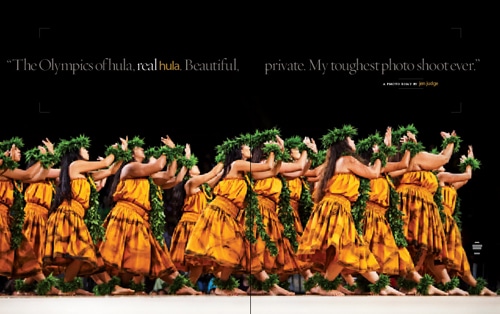Hawaii's Real Hula
What happened when you arrived at the Merrie Monarch festival?
I was in shock. People were speaking Hawaiian. Not just a few words – full conversations. I was designated a halau's (hula school) photographer, but I wasn't given a seat and was limited to this one little spot near the stage when they performed. Worse, there were hundreds of Hawaiian formalities in place at an event like this. Don't make eye contact. Take off your shoes and align them on the floor just so. Don't point your camera there. Don't put your butt where it doesn't belong. I was breaking rules without knowing it among leaders of the Hawaiian community. Thankfully, Lynn Cook, one of the veteran members of the halau helped me. But any fears I had entering this shoot only escalated once there.
But isn't hula the dance that welcomes outsiders?
The hula you see in hotels is for tourists. The Merrie Monarch Festival showcases authentic hula in its purest form. It isn't tainted by tourism. Preserving this type of hula was a big concern. So I set out to show what makes this type of hula special – not by documenting the festival itself, but by telling the story of one halau (hula troop). I figured that's a side of Hula not many people ever get access to seeing. My goal was to get behind the scenes and reveal the intimate relationships between the girls, their halau and their kumu (teacher).
How were you introduced to the halau?
It was like, "By the way there's this photographer. You'll see her here and there." That was it, and that was a problem. I didn't want this photo essay to simply showcase the event. My challenge was getting the halau's kumu (teacher), named Mapuana de Silva, to let me shoot the dancers off stage. But after day one, I realized what I wanted was going to be extremely difficult to get. Mapu didn't want me shooting the girls out of context, which meant I was limited to that two-foot space next to the stage. So I had to come up with a plan.
What'd you do?
I set up a photo booth under the concrete bleachers where the girls prep. This area was closed off with drapes, and initially I wasn't even allowed to peek my head in. So I set up a photo booth just outside to catch the girls as they came off the stage. But Mapu saw my booth, and with one look to Lynn, I knew it wasn't going to happen and I took it down.
Why was everyone so guarded?
Most of the fears are based on how hula has been portrayed by tourism. Also, Lynn called the Merrie Monarch Festival the Olympics of hula, stating you can't just get in the face of an athlete and snap photos as they prepare for competition. Halaus from all the Hawaiian Islands prepare all year for the event. It's an intense process. Every dress and lei must be identical so a group moves as one. A single lei leaf falling on the dance floor deducts points. So everything is crafted with staggering detail, and culminates with a final dress check from Mapu just before going onstage. If a dancer meets her approval, Mapu ties a lei around her neck, and whispers a personal message. It feels a bit like a coronation, and while I couldn't hear what Mapu whispered, I could tell this was a deeply personal moment between a student and teacher.
How did you get access to photograph all this?
I think that because I was honest, followed the rules, and asked appropriate questions, Mapu eventually opened up. Every day Lynn was allowed to grant me a little more access. Each day another barrier came down – especially as they all began to understand the story I was trying to tell.
What were some of the other surprises?
Well, the big wake up that Hawaii is very much its own nation. The island locals are embracing their culture and traditional ways more than ever, and this event reflects that movement. It's beautiful. People come from all over the world. Hotels sell out. The event is a big deal. It even employs the island's local motorcycle club (KOA) for security. They wore leather jackets. They had tattoos. It was quite a contrast to see all these girls and their flowery dresses next to these hardcore security guards, who were actually quite nice.
What makes this form of hula different?
The dancers move as one on stage, floating from one movement to the next in a ghostly levitation. The hotel hulas I've seen look like a series of individual poses. Strangely, the hula competition itself wasn't the highlight for the dancers at the event. They seemed more motivated by the happenings afterward, dancing at Hawaii Volcanoes National Park to pay their respects to Pele, the Hawaiian goddess of volcanoes. They danced through the rain and bursts of sunshine that seem scripted to their movements. If you happened to be in the park that day, you could witness it all.
Any tips for travelers who want to see real hula for themselves?
Get tickets to the Merrie Monarch Festival, which is held April 8-14, 2012. Also, check out what my new friend and freelance writer Lynn Cook offers on hula, and the halau that I followed (here). There's a lot to appreciate about this tradition that goes far beyond the hula we think we know.
